

AlphaLISA SureFire Ultra Human Total p21 CiP1 Detection Kit, 10,000 Assay Points
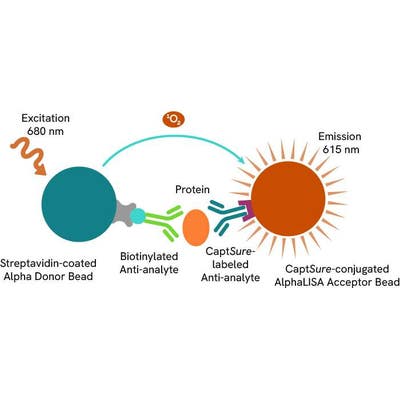
AlphaLISA SureFire Ultra Human Total p21 CiP1 Detection Kit, 10,000 Assay Points
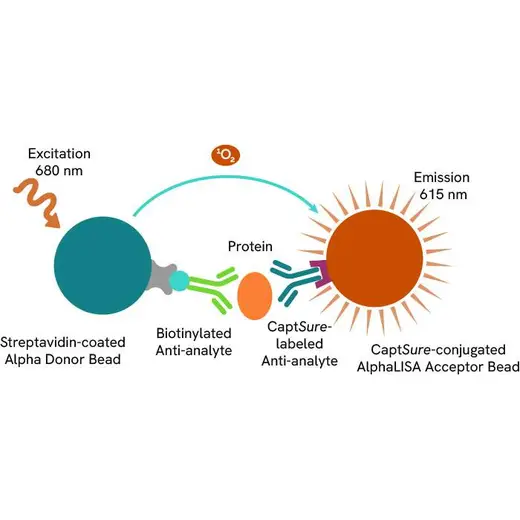

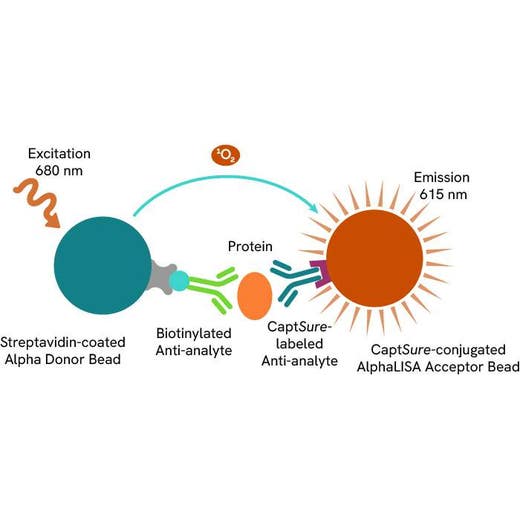

The AlphaLISA™ SureFire® Ultra™ Human Total p21 CiP1 assay is a sandwich immunoassay for quantitative detection of total p21 CiP1 in cellular lysates using Alpha Technology.
For research use only. Not for use in diagnostic procedures. All products to be used in accordance with applicable laws and regulations including without limitation, consumption and disposal requirements under European REACH regulations (EC 1907/2006).
| Feature | Specification |
|---|---|
| Application | Protein Quantification |
The AlphaLISA™ SureFire® Ultra™ Human Total p21 CiP1 assay is a sandwich immunoassay for quantitative detection of total p21 CiP1 in cellular lysates using Alpha Technology.
For research use only. Not for use in diagnostic procedures. All products to be used in accordance with applicable laws and regulations including without limitation, consumption and disposal requirements under European REACH regulations (EC 1907/2006).


AlphaLISA SureFire Ultra Human Total p21 CiP1 Detection Kit, 10,000 Assay Points


AlphaLISA SureFire Ultra Human Total p21 CiP1 Detection Kit, 10,000 Assay Points


Product information
Overview
Cyclin-dependent kinase inhibitor 1 (p21 CiP1), also known as CDKN1A, is a potent inhibitor of cyclin-dependent kinases and is involved in cell cycle regulation. p21 inhibits the activity of CDK2 and CDK4 complexes, leading to cell cycle arrest in the G1 phase, and is regulated by the tumor suppressor protein p53 in response to DNA damage. p21 Cip1 has a dual role in cancer. It can act as a tumor suppressor by inhibiting cell proliferation and promoting DNA repair. However, in some contexts, it can also promote tumorigenesis by inhibiting apoptosis and allowing cancer cells to survive. Increased expression of p21 Cip1 is also associated with cellular senescence, that contributes to aging and age-related diseases.
The AlphaLISA SureFire Ultra Human Total p21 CiP1 Detection Kit is a sandwich immunoassay for the quantitative detection of total p21 CiP1 in cellular lysates, using Alpha Technology.
Formats:
- The HV (high volume) kit contains reagents to run 100 wells in 96-well format, using a 60 μL reaction volume.
- The 500-point kit contains enough reagents to run 500 wells in 384-well format, using a 20 μL reaction volume.
- The 10,000-point kit contains enough reagents to run 10,000 wells in 384-well format, using a 20 μL reaction volume.
- The 50,000-point kit contains enough reagents to run 50,000 wells in 384-well format, using a 20 μL reaction volume.
AlphaLISA SureFire Ultra kits are compatible with:
- Cell and tissue lysates
- Antibody modulators
- Biotherapeutic antibodies
Alpha SureFire Ultra kits can be used for:
- Cellular kinase assays
- Receptor activation studies
- Screening
Specifications
| Application |
Protein Quantification
|
|---|---|
| Automation Compatible |
Yes
|
| Brand |
AlphaLISA SureFire Ultra
|
| Detection Modality |
Alpha
|
| Host Species |
Human
|
| Molecular Modification |
Total
|
| Product Group |
Kit
|
| Shipping Conditions |
Shipped in Blue Ice
|
| Target |
p21 CiP1
|
| Target Class |
Phosphoproteins
|
| Target Species |
Human
|
| Technology |
Alpha
|
| Therapeutic Area |
Oncology
|
| Unit Size |
10,000 Assay Points
|
How it works
Total-AlphaLISA SureFire Ultra assay principle
The Total-AlphaLISA SureFire Ultra assay measures the expression level of a protein target in a cell lysate.
The Total-AlphaLISA SureFire Ultra assay uses two antibodies which recognize two different distal epitopes on the targeted protein. AlphaLISA assays require two bead types: Acceptor and Donor beads. Acceptor beads are coated with a proprietary CaptSure™ agent to specifically immobilize the assay specific antibody, labeled with a CaptSure™ tag. Donor beads are coated with streptavidin to capture one of the detection antibodies, which is biotinylated. In the presence of targeted protein, the two antibodies bring the Donor and Acceptor beads in close proximity whereby the singlet oxygen transfers energy to excite the Acceptor bead, allowing the generation of a luminescent Alpha signal. The amount of light emission is directly proportional to the quantity of protein present in the sample.

Total-AlphaLISA SureFire Ultra two-plate assay protocol
The two-plate protocol involves culturing and treating the cells in a 96-well plate before lysis, then transferring lysates into a 384-well OptiPlate™ plate before the addition of Total-AlphaLISA SureFire Ultra detection reagents. This protocol permits the cells' viability and confluence to be monitored. In addition, lysates from a single well can be used to measure multiple targets.
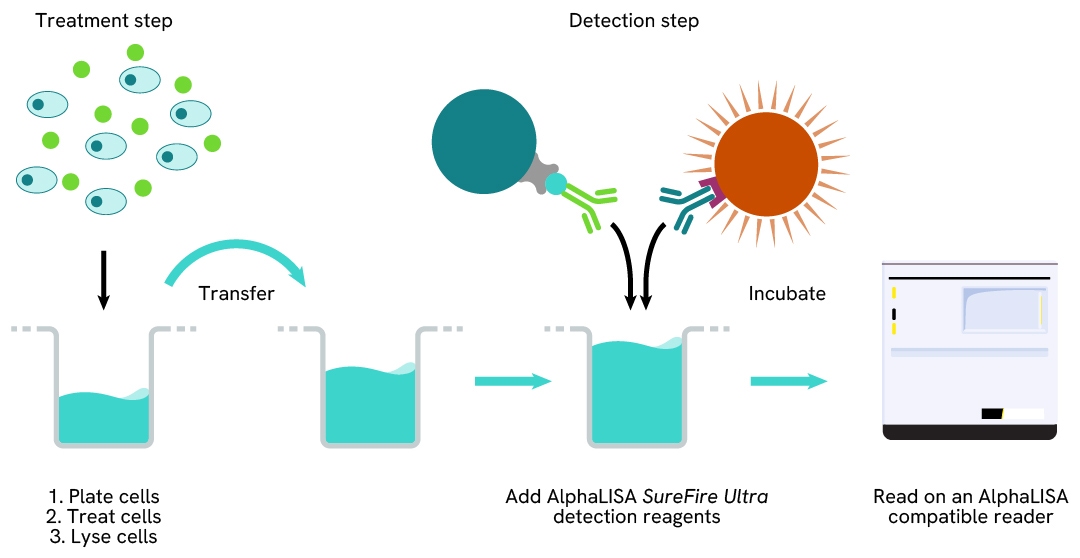
Total-AlphaLISA SureFire Ultra one-plate assay protocol
Detection of Total target protein with AlphaLISA SureFire Ultra reagents can be performed in a single plate used for culturing, treatment, and lysis. No washing steps are required. This HTS designed protocol allows for miniaturization while maintaining AlphaLISA SureFire Ultra quality.
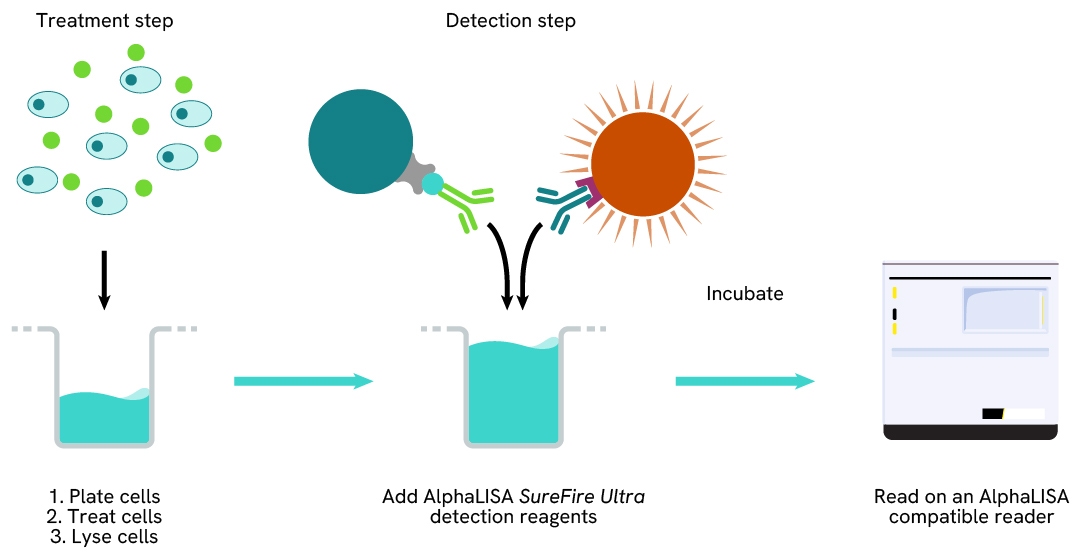
Assay validation
Activation of total p21 CiP1 in Doxorubicin treated cells
MCF7 cells were seeded in a 96-well plate (40,000 cells/well) in complete medium, and incubated overnight at 37°C, 5% CO2. The cells were treated with increasing concentrations of Doxorubicin for 18 hours.
After treatment, the cells were lysed with 100 µL of Lysis Buffer for 10 minutes at RT with shaking (350 rpm). p21 CiP1 Total and Cofilin Total levels were evaluated using respective AlphaLISA SureFire Ultra assays. For the detection step, 10 µL of cell lysate (approximately 4,000 cells and approximately 80 cells for Cofilin Total) was transferred into a 384-well white OptiPlate, followed by 5 µL of Acceptor mix and incubated for 1 hour at RT. Finally, 5 µL of Donor mix was then added to each well and incubated for 1 hour at RT in the dark. The plate was read on an Envision using standard AlphaLISA settings.
As expected, Doxorubicin triggered a dose-dependent increase in the levels of Total p21 CiP1 while Total Cofilin levels remained unchanged.
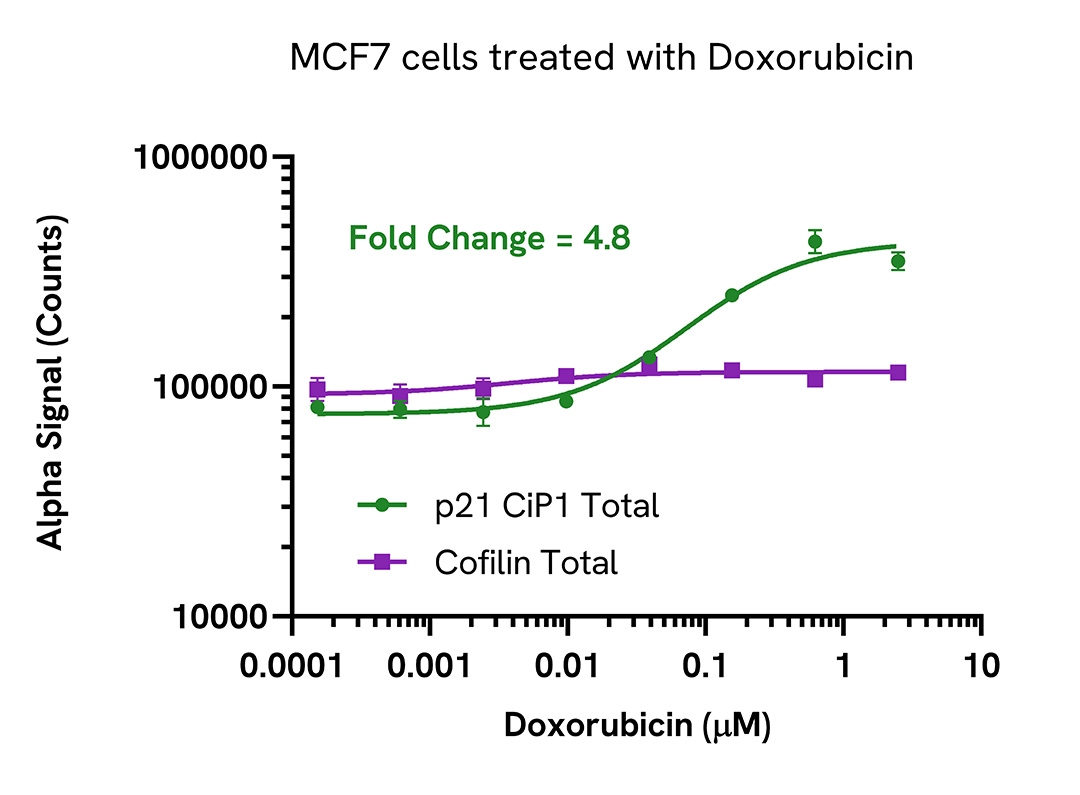
Decrease of total p21 CiP1 in Thapsigargin treated cells
SH-SY5Y cells were seeded in a 96-well plate (40,000 cells/well) in complete medium, and incubated overnight at 37°C, 5% CO2. The cells were treated with increasing concentrations of Thapsigargin for 3 hours.
After treatment, the cells were lysed with 100 µL of Lysis Buffer for 10 minutes at RT with shaking (350 rpm). p21 CiP1 Total and GAPDH Total levels were evaluated using respective AlphaLISA SureFire Ultra assays. For the detection step, 10 µL of cell lysate (approximately 4,000 cells) was transferred into a 384-well white OptiPlate, followed by 5 µL of Acceptor mix and incubated for 1 hour at RT. Finally, 5 µL of Donor mix was then added to each well and incubated for 1 hour at RT in the dark. The plate was read on an Envision using standard AlphaLISA settings.
Thapsigargin triggered a dose-dependent decrease in the levels of p21 CiP1 Total in SH-SY5Y cells while Total GAPDH levels remained unchanged.
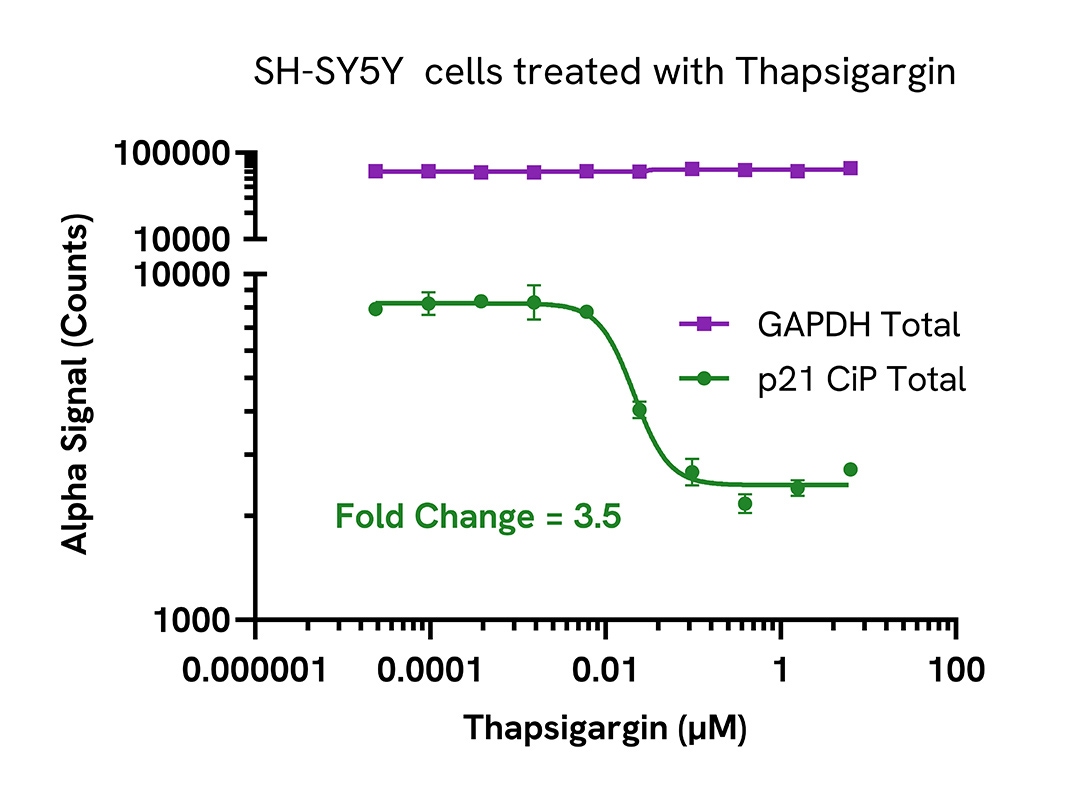
Assay versatility
Differential expression of p21 CiP1 total in human and mouse cell lines
Human and mouse cells lines were seeded at 40,000 cells/well in a 96-well culture plate in complete medium and incubated overnight at 37°C, 5% CO2. The cells were lysed the following day with 100 µL of Lysis Buffer.
p21 CiP1 Total levels were evaluated using the AlphaLISA SureFire Ultra assay. For the detection step, 10 µL (approximately 4,000 cells) of cell lysate were transferred into a 384-well white OptiPlate, followed by 5 µL of Acceptor Mix and incubated for 1 hour at RT. Finally, 5 µL of Donor Mix was then added to each well and incubated for 1 hour at RT in the dark. The plate was read on an Envision using standard AlphaLISA settings.
Total p21 CiP1 expression was detected across all human and mouse adherent cell lines tested. A very high level of expression was detected in HeLa, HEK293 and SW 1573 cells, with lower expression in A431, SH-SY5Y, HEK293T, RAW 264.7 and NIH/3T3 cells, demonstrating Total p21 CiP1 assay versatility.
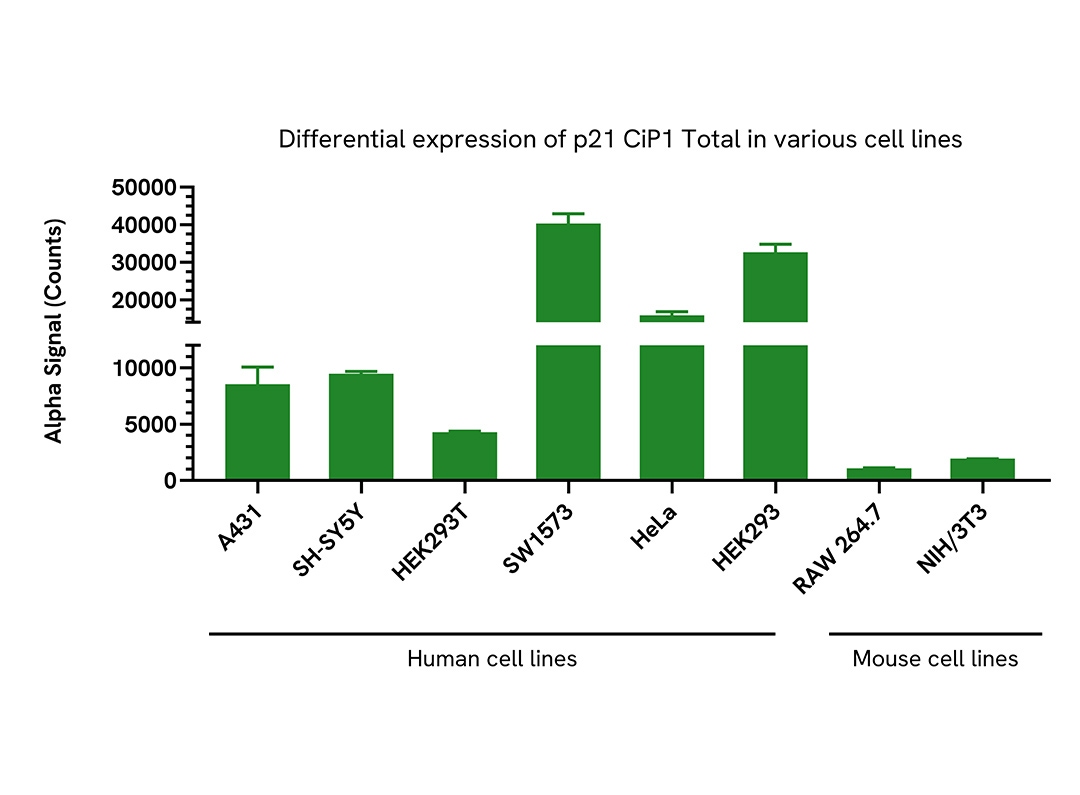
SDS, COAs, Manuals and more
Are you looking for technical documents related to the product? We have categorized them in dedicated sections below. Explore now.
- Language-Country-
- Resource TypeManualLanguageEnglishCountry-


How can we help you?
We are here to answer your questions.

































